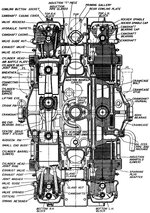re Heat conduction of sleeves
Ricardo stated:
(2) That a moving sleeve, provided that only a thin oil film was maintained, appeared to be almost transparent to heat.
"The High-Speed Internal-Combustion Engine", Ricardo, Fourth Edition, 1954 Reprint, p349. [Ricardo made significant changes between editions.]
Fedden's paper "The Development of the Mono-Sleeve Valve for Aero Engines" Feb, 1939 stated in response to a question:
"I must again emphasize Mr. Ricardo's remarks about the transparency of the sleeve and the rubbing motion of the oil film, which is the real crux of that problem."
I had to do a heat transfer calculation on a 1/2" pipe at 1300°F, and was surprised to see that the temperature difference across the carbon steel pipe was 0.84 K. I changed the conduction coefficient to that of KE965 and the thickness to 1/8" and ran calcs from 2500°F to 500°F. I found that the temperature difference across the sleeve varied from 8 K at 2500°F to 0.5 K at 500°F. For me there seems no reason to doubt Ricardo's claim, with the same caveat - the oil film must be maintained.
There are certainly many metal alloys with very good heat conductivity. I suspect we shouldn't discount the effect of the oil film, particularly if there are voids (bubbles) in the film, that could cause the heat conductivity to drop dramatically. If the interface between the cylinder wall and the sleeve insulate the sleeve, it doesn't help that much if the sleeve itself has good heat conductivity.
The enginehistory.org site has a paper about sleeve valves referring to two articles by Fedden [1] and Hives [2] claiming a measured 50C difference in piston temps vs a comparable poppet valve engine. If this is representative of sleeve valve engines in general, that's quite a huge difference.
[1] Fedden, A.H.R., "Aircraft Power Plants – Past and Future," Journal of the Royal Aeronautic Society, Vol. 48, pp. 397-459, October 1944.
[2] Hives, E.W. and Smith, F.L., "High Output Aircraft Engines," SAE Journal, Vol. 46, No. 3, pp. 106-117, March 1940.

